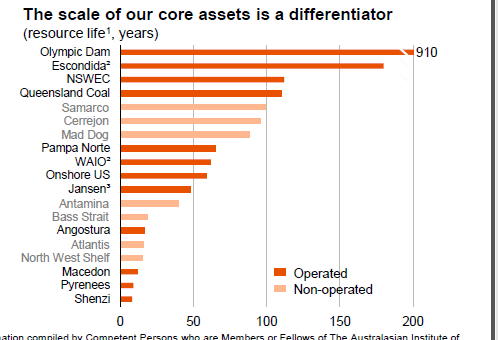The value and longevity of BHP’s Olympic Dam mine has been upgraded to a 200 year resource with almost limitless resources
Outlining its new corporate strategy in a global statement last night, BHP listed Olympic Dam as a core asset with a longer life than any other asset in his portfolio.
“Our strategy is to own and operate large, long-life, low-cost, expandable, upstream assets diversified by commodity, geography and market,” BHP’s “unlocking shareholder value” presentation said.
“We will maintain broad exposure to steelmaking, raw materials, copper, energy and potentially agricultural markets.”
BHP’s “simpler and more productive” strategy is focussed on seven key operating mineral assets and five petroleum assets.
They include Western Australian iron ore, South American oil and gas, Queensland coal, NSW coal, Chilean copper, South Australian copper and uranium, Canadian potash and US oil and gas.
“The BHP Billiton of the future will be concentrated on some of the world’s best ore bodies of enormous scale,” BHP CEO Andrew McKenzie told media and analysts last night.
“There are tens — or hundred plus years — of resources waiting to be developed by what we think will be increasingly an advanced manufacturing approach because of that longevity and world-leading scale.”
The presentation listed Olympic Dam as its most lasting asset.
Previous estimates have put the copper, gold and uranium mine’s life at somewhere between 50 and 100 years.
Last night’s presentation placed it at 200 years, and possibly “off the scale”.
The limits of the mine’s mineralisation is yet to be determined; however, it remains a resource that is difficult to recover and process.
The mine was first unlocked by Western Mining Corporation in 1956 and was acquired by BHP in 2005.
It holds the world’s biggest uranium deposit, the fifth-biggest copper deposit and the third-biggest gold deposit.
Shortly after picking up the asset, BHP began work on a major expansion of the mine.
It aimed to triple production by removing the dirt above the resource and building a massive open cut mine.
The capital cost of that project didn’t stack up when presented to the company’s board in 2012 and the project was cancelled.
BHP is now working on a longer, slower extraction process.
It’s currently conducting research trials at geology laboratory Bureau Veritas’s Adelaide site.
The mining process called heap leaching is being tested in a three-year trial.
The ore is “heaped” and a mix of acids and other chemicals drip through the ore.
It’s still in its experimental stage and any expansion of the mine is at least six years away.
While Olympic Dam might not have delivered the State Government’s much-hoped-for “economic transformation”, it will be around as a productive mine for some 200 years.






